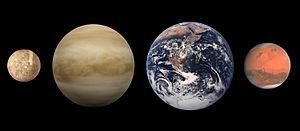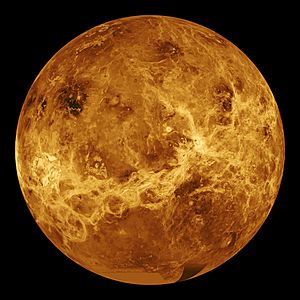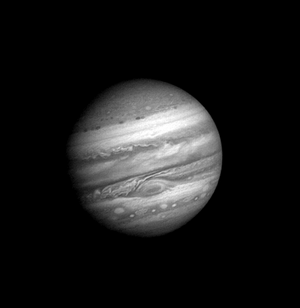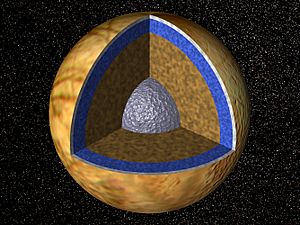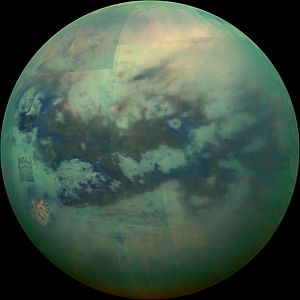Extraterrestrial life facts for kids
Extraterrestrial life is life that is not from the planet Earth. It is alien life. It is reasonable that planets rather like ours exist, and that life might evolve there also. So far none has been found, though it is possible that life once existed on Mars.
Searches have been made for signals from extraterrestrial life-forms. No signals have been received.
It is not a new idea. Quite a few philosophers have speculated on the existence of other planets like ours, with the idea that what happened here could also happen there. One thing we do know is that many other star systems do have exoplanets.
Contents
Biochemical basis
Life on Earth requires water as its solvent in which biochemical reactions take place. Sufficient quantities of carbon and other elements, along with water, might enable the formation of living organisms on terrestrial planets with a chemical make-up and temperature range similar to that of Earth. More generally, life based on ammonia (rather than water) has been suggested, though this solvent appears less suitable than water. It is also conceivable that there are forms of life whose solvent is a liquid hydrocarbon, such as methane, ethane or propane.
About 29 chemical elements play an active positive role in living organisms on Earth. About 95% of this living matter is built upon only six elements: carbon, hydrogen, nitrogen, oxygen, phosphorus and sulfur. These six elements form the basic building blocks of virtually all life on Earth, whereas most of the remaining elements are found only in trace amounts. The unique characteristics of carbon make it unlikely that it could be replaced, even on another planet, to generate the biochemistry necessary for life. The carbon atom has the unique ability to make four strong chemical bonds with other atoms, including other carbon atoms. These covalent bonds have a direction in space, so that carbon atoms can form the skeletons of complex 3-dimensional structures with definite architectures such as nucleic acids and proteins. Carbon forms more compounds than all other elements combined. The great versatility of the carbon atom makes it the element most likely to provide the bases—even exotic ones—for the chemical composition of life on other planets.
Planetary habitability in the Solar System
Some bodies in the Solar System have the potential for an environment in which extraterrestrial life can exist, particularly those with possible subsurface oceans. Should life be discovered elsewhere in the Solar System, astrobiologists suggest that it will more likely be in the form of extremophile microorganisms. Life on other worlds is most likely to include microbes, and any complex living system elsewhere is likely to have arisen from and be founded upon microbial life. Important insights on the limits of microbial life can be gleaned from studies of microbes on modern Earth, as well as their ubiquity and ancestral characteristics.
Mars may have niche subsurface environments where microbial life might exist. A subsurface marine environment on Jupiter's moon Europa might be the most likely habitat in the Solar System, outside Earth, for extremophile microorganisms.
The panspermia hypothesis proposes that life elsewhere in the Solar System may have a common origin. If extraterrestrial life was found on another body in the Solar System, it could have originated from Earth just as life on Earth could have been seeded from elsewhere (exogenesis).
The Nobel prize winner Francis Crick, along with Leslie Orgel proposed that seeds of life may have been purposely spread by an advanced extraterrestrial civilization, but considering an early "RNA world" Crick noted later that life may have originated on Earth.
Venus
In the early 20th century, Venus was often thought to be similar to Earth in terms of habitability, but observations since the beginning of the Space Age have revealed that Venus's surface is inhospitable to Earth-like life. However, between an altitude of 50 and 65 kilometers, the pressure and temperature are Earth-like, and it has been speculated that thermoacidophilic extremophile microorganisms might exist in the acidic upper layers of the Venusian atmosphere. Furthermore, Venus likely had liquid water on its surface for at least a few million years after its formation.
Mars
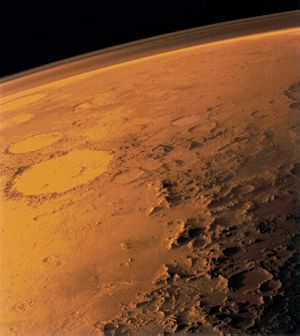
Life on Mars has been long speculated. Liquid water is widely thought to have existed on Mars in the past, and now can occasionally be found as low-volume liquid brines in shallow Martian soil. The origin of the potential biosignature of methane observed in Mars' atmosphere is unexplained, although hypotheses not involving life have also been proposed.
There is evidence that Mars had a warmer and wetter past: dried-up river beds, polar ice caps, volcanoes, and minerals that form in the presence of water have all been found. Nevertheless, present conditions on Mars' subsurface may support life. Evidence obtained by the Curiosity rover studying Aeolis Palus, Gale Crater in 2013 strongly suggests an ancient freshwater lake that could have been a hospitable environment for microbial life.
Current studies on Mars by the Curiosity and Opportunity rovers are searching for evidence of ancient life, including a biosphere based on autotrophic, chemotrophic and/or chemolithoautotrophic microorganisms, as well as ancient water, including fluvio-lacustrine environments (plains related to ancient rivers or lakes) that may have been habitable. The search for evidence of habitability, taphonomy (related to fossils), and organic carbon on Mars is now a primary NASA objective.
Ceres
Ceres, the only dwarf planet in the asteroid belt, has a thin water-vapor atmosphere. Frost on the surface may also have been detected in the form of bright spots. The presence of water on Ceres has led to speculation that life may be possible there.
Jupiter system
Jupiter
Carl Sagan and others in the 1960s and 1970s computed conditions for hypothetical microorganisms living in the atmosphere of Jupiter. The intense radiation and other conditions, however, do not appear to permit encapsulation and molecular biochemistry, so life there is thought unlikely. In contrast, some of Jupiter's moons may have habitats capable of sustaining life. Scientists have indications that heated subsurface oceans of liquid water may exist deep under the crusts of the three outer Galilean moons—Europa, Ganymede, and Callisto. The EJSM/Laplace mission is planned to determine the habitability of these environments.
Europa
Jupiter's moon Europa has been subject to speculation about the existence of life due to the strong possibility of a liquid water ocean beneath its ice surface. Hydrothermal vents on the bottom of the ocean, if they exist, may warm the ice and could be capable of supporting multicellular microorganisms. It is also possible that Europa could support aerobic macrofauna using oxygen created by cosmic rays impacting its surface ice.
The case for life on Europa was greatly enhanced in 2011 when it was discovered that vast lakes exist within Europa's thick, icy shell. Scientists found that ice shelves surrounding the lakes appear to be collapsing into them, thereby providing a mechanism through which life-forming chemicals created in sunlit areas on Europa's surface could be transferred to its interior.
On 11 December 2013, NASA reported the detection of "clay-like minerals" (specifically, phyllosilicates), often associated with organic materials, on the icy crust of Europa. The presence of the minerals may have been the result of a collision with an asteroid or comet according to the scientists. The Europa Clipper, which would assess the habitability of Europa, is planned for launch in 2025. Europa's subsurface ocean is considered the best target for the discovery of life.
Saturn system
Titan and Enceladus have been speculated to have possible habitats supportive of life.
Enceladus
Enceladus, a moon of Saturn, has some of the conditions for life, including geothermal activity and water vapor, as well as possible under-ice oceans heated by tidal effects. The Cassini–Huygens probe detected carbon, hydrogen, nitrogen and oxygen—all key elements for supporting life—during its 2005 flyby through one of Enceladus's geysers spewing ice and gas. The temperature and density of the plumes indicate a warmer, watery source beneath the surface.
Titan
Titan, the largest moon of Saturn, is the only known moon in the Solar System with a significant atmosphere. Data from the Cassini–Huygens mission refuted the hypothesis of a global hydrocarbon ocean, but later demonstrated the existence of liquid hydrocarbon lakes in the polar regions—the first stable bodies of surface liquid discovered outside Earth. Analysis of data from the mission has uncovered aspects of atmospheric chemistry near the surface that are consistent with—but do not prove—the hypothesis that organisms there if present, could be consuming hydrogen, acetylene and ethane, and producing methane.
Small Solar System bodies
Small Solar System bodies have also been speculated to host habitats for extremophiles. Fred Hoyle and Chandra Wickramasinghe have proposed that microbial life might exist on comets and asteroids.
Other bodies
Models of heat retention and heating via radioactive decay in smaller icy Solar System bodies suggest that Rhea, Titania, Oberon, Triton, Pluto, Eris, Sedna, and Orcus may have oceans underneath solid icy crusts approximately 100 km thick. Of particular interest in these cases is the fact that the models indicate that the liquid layers are in direct contact with the rocky core, which allows efficient mixing of minerals and salts into the water. This is in contrast with the oceans that may be inside larger icy satellites like Ganymede, Callisto, or Titan, where layers of high-pressure phases of ice are thought to underlie the liquid water layer.
Hydrogen sulfide has been proposed as a hypothetical solvent for life and is quite plentiful on Jupiter's moon Io, and may be in liquid form a short distance below the surface.
Scientific search
The scientific search for extraterrestrial life is being carried out both directly and indirectly. As of September 2017[update], 3,667 exoplanets in 2,747 systems have been identified, and other planets and moons in our own solar system hold the potential for hosting primitive life such as microorganisms.
Direct search
Scientists search for biosignatures within the Solar System by studying planetary surfaces and examining meteorites. Some claim to have identified evidence that microbial life has existed on Mars. An experiment on the two Viking Mars landers reported gas emissions from heated Martian soil samples that some scientists argue are consistent with the presence of living microorganisms. Lack of corroborating evidence from other experiments on the same samples, indicates that a non-biological reaction is a more likely hypothesis. In 1996, a controversial report stated that structures resembling nanobacteria were discovered in a meteorite, ALH84001, formed of rock ejected from Mars.

In February 2005, NASA scientists reported that they may have found some evidence of present life on Mars. The two scientists, Carol Stoker and Larry Lemke of NASA's Ames Research Center, based their claim on methane signatures found in Mars's atmosphere resembling the methane production of some forms of primitive life on Earth, as well as on their own study of primitive life near the Rio Tinto river in Spain. NASA officials soon distanced NASA from the scientists' claims, and Stoker herself backed off from her initial assertions. Though such methane findings are still debated, support among some scientists for the existence of life on Mars exists.
In November 2011, NASA launched the Mars Science Laboratory that landed the Curiosity rover on Mars. It is designed to assess the past and present habitability on Mars using a variety of scientific instruments. The rover landed on Mars at Gale Crater in August 2012.
The Gaia hypothesis stipulates that any planet with a robust population of life will have an atmosphere in chemical disequilibrium, which is relatively easy to determine from a distance by spectroscopy. However, significant advances in the ability to find and resolve light from smaller rocky worlds near their star are necessary before such spectroscopic methods can be used to analyze extrasolar planets. To that effect, the Carl Sagan Institute was founded in 2014 and is dedicated to the atmospheric characterization of exoplanets in circumstellar habitable zones. Planetary spectroscopic data will be obtained from telescopes like WFIRST and ELT.
In August 2011, findings by NASA, based on studies of meteorites found on Earth, suggest DNA and RNA components (adenine, guanine and related organic molecules), building blocks for life as we know it, may be formed extraterrestrially in outer space. In October 2011, scientists reported that cosmic dust contains complex organic matter ("amorphous organic solids with a mixed aromatic-aliphatic structure") that could be created naturally, and rapidly, by stars. One of the scientists suggested that these compounds may have been related to the development of life on Earth and said that, "If this is the case, life on Earth may have had an easier time getting started as these organics can serve as basic ingredients for life."
In August 2012, and in a world first, astronomers at Copenhagen University reported the detection of a specific sugar molecule, glycolaldehyde, in a distant star system. The molecule was found around the protostellar binary IRAS 16293-2422, which is located 400 light years from Earth. Glycolaldehyde is needed to form ribonucleic acid, or RNA, which is similar in function to DNA. This finding suggests that complex organic molecules may form in stellar systems prior to the formation of planets, eventually arriving on young planets early in their formation.
Related pages
Images for kids
-
Astronomers have discovered stars in the Milky Way galaxy that are almost 13.6 billion years old.
-
The Green Bank Telescope is one of the radio telescopes used by the Breakthrough Listen project to search for alien communications
-
Artist's impression of Gliese 581 c, the first terrestrial extrasolar planet discovered within its star's habitable zone
-
Artist's impression of the Kepler telescope
-
The statue of Simandhara, an enlightened man in Jain mythology who is believed to be residing on another planet
-
The Wow! signal represented as "6EQUJ5". The original printout with Ehman's handwritten exclamation is preserved by Ohio History Connection. It was pointed towards the Proxima Centauri system. The signal was used to support the search for extraterrestrial intelligence.
See also
 In Spanish: Vida extraterrestre para niños
In Spanish: Vida extraterrestre para niños



